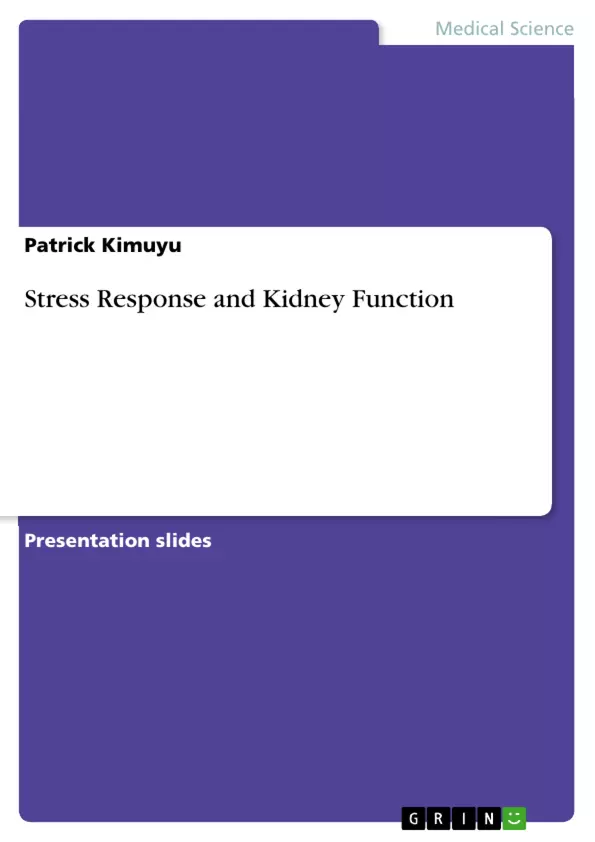Overall, the excretory system plays key physiological role in the body.
Of great physiological significance are the kidneys.
Therefore, the objective of this presentation is to present an overview of the impact of stress on kidney functions.
Inhaltsverzeichnis (Table of Contents)
- INTRODUCTION
- Kidney Structure
- Function of Kidneys
- Structure and Function of Kidneys
- (a)Structure of the Kidney
- (b)Structure and Function of Nephron
- HOW THE KIDNEY REGULATES BP?
- STRESS HORMONE(S) INVOLVED IN BP REGULATION
- HOW THE KIDNEYS RESPOND TO DEHYDRATION
- EFFECT OF CAFFEINE ON THE KIDNEY
Zielsetzung und Themenschwerpunkte (Objectives and Key Themes)
This presentation explores the crucial role of the kidneys in the human body, particularly their intricate involvement in maintaining homeostasis. The objective is to provide a comprehensive overview of the impact of stress on kidney function, highlighting key physiological mechanisms.
- The structure and function of the kidney, including its nephrons.
- The kidney's role in regulating blood pressure through the Renin-Angiotensin-Aldosterone System (RAAS).
- The influence of stress hormones, particularly vasopressin, on blood pressure regulation.
- The kidneys' response to dehydration and their mechanisms for maintaining water balance.
- The potential effects of caffeine on kidney function, particularly its relationship with blood pressure regulation.
Zusammenfassung der Kapitel (Chapter Summaries)
- INTRODUCTION: Introduces the crucial role of the excretory system, with a particular focus on the kidneys and their significance in body function. The presentation's objective is to examine the impact of stress on kidney function.
- Kidney Structure: Describes the bean-shaped structure of the kidney and its key components, including the renal capsule, cortex, medulla, and pelvis. The functional unit of the kidney, the nephron, is also introduced.
- Function of Kidneys: Highlights the crucial role of the kidneys in maintaining homeostasis, including regulating acid levels, blood pressure, and water balance. It also emphasizes the kidneys' role in waste excretion and red blood cell production.
- Structure and Function of Kidneys: This chapter delves deeper into the kidney's structure and function, providing a detailed breakdown of the nephron and its components. It presents diagrams illustrating the structure of the kidney and the nephron.
- HOW THE KIDNEY REGULATES BP?: Explains how kidneys regulate blood pressure through the Renin-Angiotensin-Aldosterone System (RAAS). The mechanism involves the release of renin, its conversion of angiotensinogen, and the resulting constriction of blood vessels to maintain normal blood pressure.
- STRESS HORMONE(S) INVOLVED IN BP REGULATION: Discusses the role of vasopressin (ADH), an anti-diuretic hormone, in blood pressure regulation. It explains how situations like emotional stress, pain, and decreased ECF volume stimulate the release of vasopressin, which influences blood pressure.
- HOW THE KIDNEYS RESPOND TO DEHYDRATION: Describes the kidneys' response to dehydration through a hypothalamic controlled mechanism. An increase in osmotic plasma pressure triggers the release of vasopressin, leading to increased water retention and a decrease in osmotic plasma pressure.
- EFFECT OF CAFFEINE ON THE KIDNEY: Explores the potential impact of caffeine on kidney function. While conflicting findings exist, research suggests caffeine increases blood pressure, potentially interfering with the kidneys' blood pressure regulation mechanisms.
Schlüsselwörter (Keywords)
The primary keywords and focus topics of this presentation include: kidneys, excretory system, homeostasis, stress, blood pressure regulation, Renin-Angiotensin-Aldosterone System (RAAS), vasopressin, dehydration, water balance, caffeine, nephron, glomerulus, Bowman's capsule, renal cortex, renal medulla, renal pelvis, functional unit.
- Citar trabajo
- Patrick Kimuyu (Autor), 2018, Stress Response and Kidney Function, Múnich, GRIN Verlag, https://www.grin.com/document/411950



